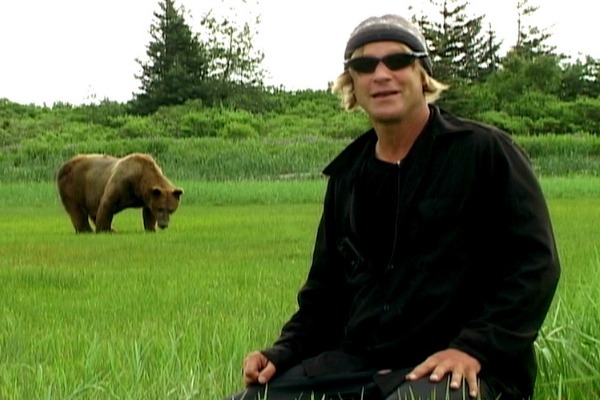Movie review by Greg Carlson
Admirers of veteran filmmaker Werner Herzog’s impressive body of work will not want to miss “Grizzly Man,” an engrossing documentary that blends Herzog’s ferocious hunger for knowledge with a hair-raising tale of one man’s fatal relationship with the wild bears in Alaska’s Katmai National Park. Like so many of Herzog’s oddities, outcasts, and misguided iconoclasts, subject Timothy Treadwell embarks on a seemingly mad and certainly reckless journey of self-discovery that requires participation in unthinkably perilous behavior as a measure of one’s mettle. “Grizzly Man” reveals immediately that Treadwell and girlfriend Amie Huguenard were killed and eaten by a bear (or bears) in October of 2003, and Herzog uses the incident as a jumping-off point for a discussion of, among other things, the desire for celebrity and the commodification of nature for personal gain.
“Grizzly Man” is composed largely of Treadwell’s own video footage, which he began compiling in 1999. Shot in the style of a Discovery Channel or Animal Planet series in which a “Crocodile Hunter” host lays it on thick while presumably teaching viewers something about the wild, Treadwell’s clips tell us a great deal more about Treadwell than the animals he claims he is there to protect. Several times, Treadwell loses his thread and launches into profanity-laced, paranoid rants in which he casts himself as a lone champion of the bears. Herzog occasionally comments in voiceover, but Treadwell does not need any help in terms of making himself sound like a raving, delusional, and terribly naive fool.
With his sandy, Prince Valiant locks and his surfer dude attitude, Treadwell seems much younger than his real age (he was born in 1957), and his playful, child-like demeanor contributes to a sense of arrested development. He calls the bears by pet names like Mr. Chocolate and Sergeant Brown, and tells the animals over and over how much he loves them. Several times, Treadwell breaks down in tears on camera as he struggles to explain just how closely he identifies with these creatures (in one absolutely hilarious moment, Treadwell chokes up over what he thinks is a dead bee). While Herzog manipulates the chronology of some of the footage, Treadwell emerges as a deeply troubled person whose inability to connect with human society fascinates the director.
Treadwell’s close encounters with the 800-pound behemoths are often breathtaking, and Herzog clearly admires his subject’s devotion to single-minded documentation. Several times, Treadwell finds himself nose to nose with a bear, and his determined tactics to interact peacefully with the animals are chilling to see. Treadwell became so accustomed to turning on his video camera whenever a bear wandered by, an audio recording of his own death was captured on tape (the lens cap was not removed). Herzog uses this harrowing piece of information to stage the film’s most compelling moment – rather than share the gruesome sounds with the audience, Herzog chooses to withhold them, and unheard attack ripples through the viewer’s imagination.
Herzog’s voice, clear and unflinching in its directness, provides the ideal counterpoint to Treadwell’s spacey “secret world of the bear.” The director often disagrees with Treadwell, and several of Herzog’s comments – such as the idea that when he looks at the world he sees only “chaos, hostility, and murder” or that nature itself is totally “indifferent” – resonate with a bleak sense of humor. While Treadwell practically foams at the mouth trying to attribute individual personalities to the many bears he encounters, Herzog cuts to the quick, suggesting that the bear merely regards Treadwell with a “half-bored interest in food.” Herzog himself is anything but bored by Treadwell, however, and viewers of “Grizzly Man” are beneficiaries of the great filmmaker’s curiosity.
